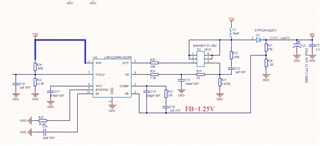Tool/software:
Hi Expert,
My customer using LM5022, but find one issue that, input 5.5V-6.5V, output is 40 V, under expectation. when input >6.5V, output will be over 40V, damaging next level, here is the schematic. please help to review.

Br
Chi
This thread has been locked.
If you have a related question, please click the "Ask a related question" button in the top right corner. The newly created question will be automatically linked to this question.
Tool/software:
Hi Expert,
My customer using LM5022, but find one issue that, input 5.5V-6.5V, output is 40 V, under expectation. when input >6.5V, output will be over 40V, damaging next level, here is the schematic. please help to review.

Br
Chi
Hello Chi,
Thanks for reaching out to us via e2e.
Some important information is missing in this thread (input voltage range, load current), but nevertheless I can give you some hints.
How did you determine the of the components for this application?
Especially the values of the compensation network are far off.
The 1µF capacitor is much too big, so it is slowing down the reaction of the voltage regulation loop and making the system instable.
To calculate the values, you could use the Powerstage Designer which you can download from here:
www.ti.com/.../POWERSTAGE-DESIGNER
Without knowing the details mentioned above, the components should be in the following range:
C18 = 33nF, R23 = 100k, C19 = 0.33nF
Please be aware that the calculated values can only be a good starting point, but the proper compensation components shall be determined by experiments and measurement on a physical board in the lab.
All information in this correspondence and in any related correspondence is provided “AS IS” and “with all faults” and is subject to TI’s Important Notice: www.ti.com/.../important-notice.shtml
Best regards
Harry
Hi Harry,
thanks for your detailed suggestion, my customer also want to know input is 8-32V, output is 18V, any risk for this use case, I didn't find specific spec for output in the datasheet.
BR
Chi
Hello Chi,
When the input voltage is rising and getting close to the targeted output voltage, the on-time of the FET will become shorter and shorter until it just stops switching.
So, when the input voltage is higher than the targeted output voltage, the FET will never turn on and all load current will just flow across the diode.
All information in this correspondence and in any related correspondence is provided “AS IS” and “with all faults” and is subject to TI’s Important Notice: www.ti.com/.../important-notice.shtml
Best regards
Harry